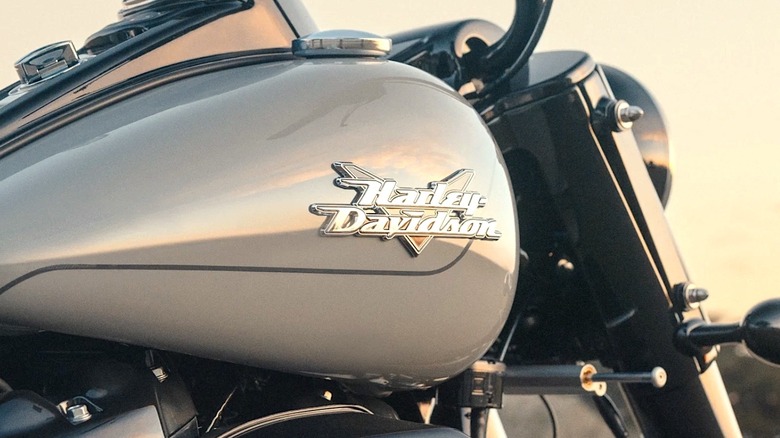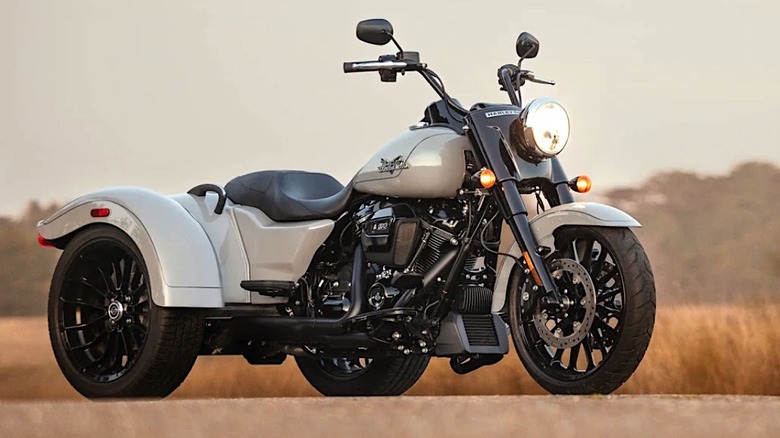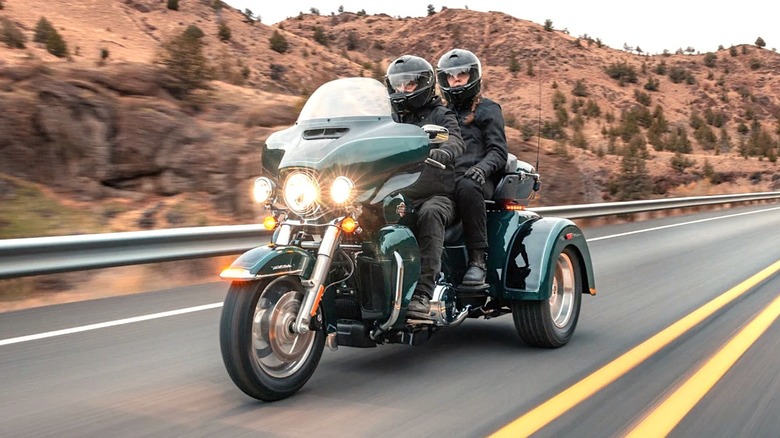What's The Difference Between Harley-Davidson Tri Glide And Freewheeler Motorcycles?
For motorcycle enthusiasts across the globe, Harley-Davidson Motorcycles have long-inspired visions of a carefree life that's lived on two wheels and an open road. The company's reputation is built on the back of more than a century of contributions to the motorcycle world, with Harley-Davidson building its first motorcycle in the early 1900s. In the years since, the fabled motorcycle company has designed and built a two-wheeled beast for virtually anyone that ever dreamt of hitting the highway astride a Harley.
However, not all of Harley-Davidson's creations are based on the traditional two-wheel model. In 1913, Harley-Davidson rolled out a motorcycle with two front wheels and one in the rear designed to open up some precious storage space. Then, the motorcycle manufacturer's so-called Servi-Car "trike" joined the roster in 1931. The trike approach was enough of a hit that Harley-Davidson continued to produce the Servi-Car for another four decades or so before it halted production in 1973. It wasn't until 2009 that Harley-Davidson once again began producing trikes with the roll-out of the Tri Glide Ultra Classic model.
These days, Harley-Davidson's Freewheeler and Tri Glide models are leading the three-wheeled pack and are arguably some of the best Harley-Davidson motorcycles ever made. At first glance, these two trikes appear to have plenty in common, each sharing a three-wheel build and roughly the same dimensions. Likewise, they're each running on a Milwaukee-Eight 114 engine. But when you compare the trikes closely, the two are different beasts designed to meet distinct on-road goals. These are the differences between Harley-Davidson's Tri Glide and Freewheeler motorcycles.
What is Harley-Davidson Freewheeler?
We'll begin our rundown with Harley-Davidson's Freewheeler Trike. Its base model is the cheaper of the two trikes, boasting a price tag of roughly $6,000 less than a base Tri Glide. A brief breakdown of each bike makes the reasons for that price a little clearer, as the Freewheeler lacks some of the luxury gusto of the Tri Glide. First of all, its passenger seat does not include a back like the Tri Glide's. The base Freewheeler also does not include Harley-Davidson's vaunted Infotainment package and has far fewer paint color options.
The Freewheeler boasts a classic Harley-Davidson look on the front end accented by pseudo-ape hangar handlebars. The trike is just as distinctive from the side and rear, with Bobtail fenders contrasting the wide-body back tires and black chrome wheels. The Freewheeler also boasts a sleek and sizable trunk, making it easy to carry some essential gear for a long day of riding or even a weekend getaway. But one of the trike's legit wow factors is the largely blacked-out underbelly, a savagely cool feature that may be responsible for Freewheeler's lack of paint options.
Of course, on longer trips, the lack of a back on the passenger seat could make for a mildly uncomfortable ride for less-than-clingy couples. Nonetheless, the Freewheeler is still a stylish and powerful touring trike fit for Harley-Davidson fans who desire more comfort and control with that vintage Harley-Davidson muscle.
What is Harley-Davidson Tri Glide?
The Harley-Davidson Tri Glide preceded the Freewheeler and was even prominently featured at the head of the motorcade for the 2009 inauguration of President Barack Obama.
As Harley-Davidson diehards can no doubt tell on first look, the Tri Glide's front-end design seems to be inspired by the company's beloved Electra Glide Ultra Classic. The aerodynamic fork-mounted batwing fairing on the front of the Tri Glide is virtually identical to an Electra Glide, even as the bike's body has understandably been modified to accommodate a three-wheel design. Given Electra Glide's status as a luxury touring legend, it's no surprise that Tri Glide is designed for a similarly luxurious ride. It boasts the backed passenger seat, easy shifting six-speed cruise drive transmission, and a robust Infotainment package that ensures you will never miss a call or a beat during longer rides or extended trips.
Tri Glide is also flashing a bit more shine on its chrome package than Harley-Davidson's blacked-out Freewheeler. Since it's designed for longer trips, the Tri Glide also offers more trunk and storage space. Though both trikes are powered by Milwaukee-Eight 114 engines, the Tri Glide utilizes the Twin-Cooled version and holds a slight edge in horsepower over the Freewheeler. You can bet riders will appreciate that boost in power when they head out on the highway looking for some serious adventure.


